






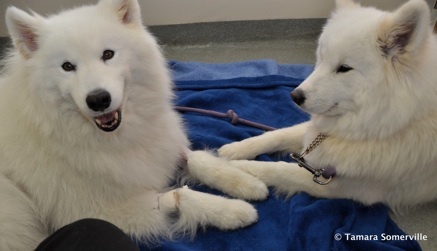
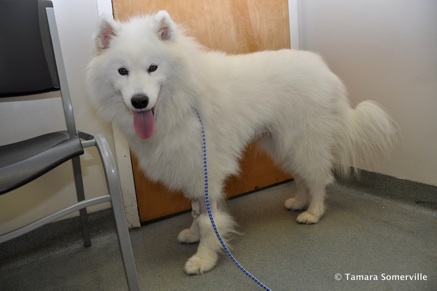
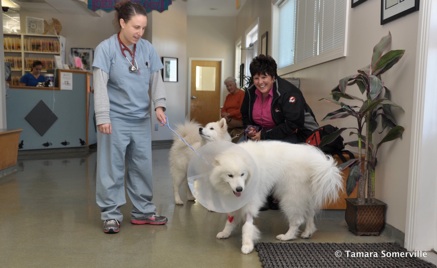
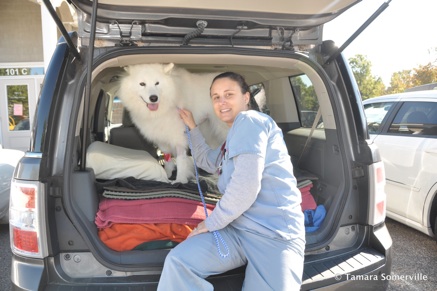
We were in a rented beach-front vacation home on the Outer Banks of North Carolina (Avon on Hatteras Island) -- 312 miles and six driving hours away from our home in Washington, D.C. It was nearing midnight on a beautiful, breezy October evening marred only by annoying illegal fireworks on the beach that had terrified all the dogs in the house for the better part of an hour. Gidget, normally fearful of thunder and other loud noises and even anxious when the car drives over rumble strips in the road, had been frightened by the fireworks to the point of panting vigorously.
While I had long known that exercising too near mealtimes could precipitate bloating, I had no idea that there is perhaps an even stronger correlation with panting from anxiety -- which draws gas into the stomach.
After a long day that had begun with a gorgeous sunrise walk and fishing on the beach, the six people and five dogs in the house were getting ready to turn out the lights for the night. I was walking into my bedroom when I noticed my 9-year old Samoyed’s, Gidget’s, absence and asked of no one in particular where she was.
“She’s downstairs trying to vomit,” said Jim, one of the house guests staying in a downstairs bedroom.
“She’s ‘trying’ to vomit?” I wondered aloud as I walked downstairs to see what she was doing. Sure enough, when I got to the bottom of the stairs there was Gidget, unsuccessfully attempting to vomit. No bile, nothing. I had never before seen her do that.
This is what is known as “unproductive” or “non-productive” vomiting. And it is a Big Red Flag -- an indicator that bloat and torsion of the stomach are occurring.

Bloat-related links - Vet Authorities




Non-Vet Bloat Info (can’t vouch for their credentials)



Gidget and the author one day after bloat-torsion surgery

Tuesday 3:30 a.m. - Gidget heads into surgery
Two days post-surgery and eager to go home
Gidget in visiting room with PVSC buddy Blaze
Gidget bolting for the exit on Discharge Day (Friday)
Gidg got goodbye hugs from vet staff, including new Facebook friend Lauren Woolard, one of her (and my) angels of mercy during her four days in the hospital.
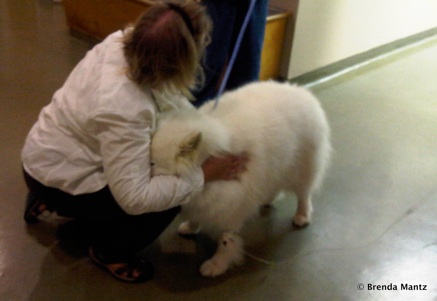
“Bloat” a.k.a. Gastric Dilatation Volvulus (GDV) kills an estimated 60,000 dogs each year. It is most prevalent among bigger breeds, with apparent correlation
to deep-chested dogs, including Samoyeds.
Thinking that some stomach contents would surely be coming forth, I gently steered Gidget off the carpet and into the nearby laundry room with its tiled floor. Several more times this unproductive vomiting occurred as she paced around the room. She belched lightly. Her back was slightly hunched.
Three more Big Red Flags of Bloat: belching/burping, pacing and a hunched or arched posture.
Unsure of what was going on but beginning to suspect bloat was a possibility, I carried Gidget upstairs to my bedroom and placed her standing on the floor. She subsequently hopped onto a large ottoman where she had slept the night before and laid down, looking pretty comfortable and easing my concern a bit. The vomiting attempts had ceased. Four of us kneeled on the floor around her to gauge her condition and look for further indication that something was amiss. It was not obvious to any of us that Gidget was in mortal danger. After several minutes of laying (apparently comfortably) on the ottoman, Gidget became fidgety and stood up.
All her life Gidget had been very stoic. At nine weeks old, she had not even flinched when the vet inserted the rectal thermometer or administered vaccinations. She would not indicate any discomfort until an ear infection was raging. She had never before in her life behaved quite as she was this night.
To know if something is amiss, you have to be attuned to your dog’s behavior and physicality in healthy times. It could save your dog’s life in the future to know what their abdomen and tummy feel like today. If bloat occurs, their abdomen will feel tight, perhaps even hard.
I ran to my car to retrieve a dog first-aid book and a first-aid kit that I’d assembled in the past year with the assistance of Gidget’s regular vet and knowledgeable dog people around the country. At the behest of some articles I’d previously read on bloat and one particularly knowledgeable friend in Washington State who has Dobermans, the Dog First-Aid kit includes Gas-X tablets. The First-Aid book reinforced my concerns about bloat. And so I asked Brenda to force a Gas-X tablet down Gidget’s throat, which may have bought Gidget enough time to survive until surgery.
Ask your vet what items should be in a Dog First-Aid kit. Ask them to explain bloat and demonstrate on your dog where you would check for signs of bloat and what those areas would feel like. Ask them to show you how to force a pill down if you do not already know. Ask them to show you how you could tell something was wrong with blood flow (i.e. “shock”) by looking at your dog’s gums.
Except for the attempts at vomiting, the symptoms were subtle. But they added up to something being wrong with Gidget. And I knew that if we were home in Washington, D.C., I would be taking her to the emergency vet that instant.
John grabbed the keys to his crew cab truck and his wife, Brenda, grabbed her purse (containing the blessed Blackberry). Emmy, Jim and Carol stayed at the house to be with the other dogs. One of the Samoyeds, 15-month old Blaze, had been entrusted to me while her owners were in Florida. She was unnerved to see Gidget and me leaving. Emmy stayed upstairs with her throughout that night.
We did not know where the nearest 24/7 veterinary hospital was but we headed north toward Nags Head and the more populated areas of the Outer Banks. Brenda had once taken their Samoyed, Arlo, to a vet there and they had an after-hours emergency number. But we called that number several times -- saying that we were in route with a 9-year old Samoyed suspected of experiencing bloat -- and never got a return call. Six days later I still have not received a return call from that Nags Head veterinarian office.
In advance of taking your pets out of your hometown, research emergency veterinarian hospitals near your vacation destination. Print out and keep in your vehicle maps, directions, addresses and phone numbers. You do not want to be fumbling around for this information when you are under duress and your dog is in a deadly situation.
Holding Gidget throughout the drive, I began to make a series of telephone calls starting with Gidget’s regular vet in the DC area: Alexandria Animal Hospital. I will be forever grateful to a veterinarian technician named Jesse who works there because through several long telephone calls during the drive, she educated me on bloat and what was happening with Gidget. She also provided the address and phone number for the emergency veterinary hospital in Chesapeake, Virginia, that was going to save Gidget’s life.
Cell phones and Brenda’s Blackberry which enabled her to get detailed directions to the emergency hospital were life-saving technologies on this evening. And John’s truck having plenty of fuel saved precious minutes. In a bloat situation, time is extremely finite.
With the Nags Head veterinary hospital not responding to our calls to their emergency after-hours telephone number, we continued north toward the Greenbrier Veterinary Emergency Center near Norfolk, Virginia. It is 121 miles away from the rental house in Avon. That was the longest drive of my life, and no doubt Gidget’s. In the backseat with Gidget, I placed repeated calls to Jesse at Alexandria Animal Hospital to get her read on what I was seeing in Gidget’s actions (she belched once and vomited bile -- good things in a bloat situation).
We got to the hospital around 2:30 a.m. I lifted Gidget out of the truck and she walked in, gingerly. The surgeon immediately felt her abdomen (said it was tight but not definitive) and got her x-rayed. The x-ray revealed that her stomach had bloated (not as big as they usually see) and had folded over on itself (torsion).
Within minutes they were preparing for surgery.
The surgeon informed us after the two-hour operation that other than slight bruising where the stomach folded, her internal organs did not incur any damage. There was no “necrosis” (tissue death) of the stomach, spleen or any other organ. This is what you hope to hear if in a bloat situation. The emergency surgeon informed the attending daytime physicians that Gidget's stomach was "beautiful."
To prevent stomach torsion in the future, the surgeon sutured Gidget’s stomach to the abdominal wall. This procedure is called: gastropexy.
Many owners of breeds (such as Great Danes) even more prone to bloat-torsion have prophylactic gastropexy performed on their dogs when they’re young, often when they are already being anesthetized or opened up for some other procedure, such as spaying. It will not prevent a future bloat incident, but torsion is far more lethal.
The prognosis from the get-go after surgery was very positive and Gidget's recovery to this point has been fantastic. By the end of the day of the surgery (Tuesday), the only vital signs that were not normal were her kidney values, which were slightly elevated. A normal occurrence, they said, after experiencing shock. By Wednesday, her kidney values were back to normal. And after being taken off the continuous pain medication IV, her eyes brightened, she smiled and wagged her tail. She received Tramadol pain pills for four additional days.
Another figure they monitor in bloat-torsion cases is lactate (indicative of tissue damage), and that was back to normal by Wednesday, as well. On Thursday, she began eating (very little) and drinking on her own -- and pulling at the leash to walk out of the building. She went home on Friday (Day 4). The abdominal incision staples were removed on Day 12. She is expected to be fully recovered four to six weeks after the surgery. It will take far longer for me to recover from knowing that Gidget suffered hours of hideous pain while in route to the hospital. And that she very nearly died in my arms.
PREVENTION
There is a lot of information about bloat-torsion on the Internet. Unfortunately, little of it is definitive as to what exactly causes bloat and torsion and what can be done to prevent it from occurring. That is because no one knows for sure. As articles at the links below indicate, certain body types (deep-chested, large dogs), personality types (fearful, prone to stress), behaviors (eating/drinking soon before or after vigorous exercise), diets, age and DNA are believed to be factors in some or many cases. But there is no check-list of things you can do which will guarantee that your pup is never the victim of bloat.
Gidget’s background includes a grandmother who bloated (and is still alive at age 16), her father who has suffered acid reflux (Gidget has, too), she’s scared of loud noises (including thunder, fireworks and certain road pavements at high speeds). She’s nine years old and her bloat-torsion attack was preceded by dinner closely followed by protracted fireworks that sounded like bombs. The fireworks caused her to hide and pant excessively.
Your dog’s chances of surviving a bloat episode hinge on your ability to swiftly recognize the symptoms and quickly get them to a veterinarian facility equipped to perform the life-saving surgical procedures to remedy bloat or, even worse: torsion.
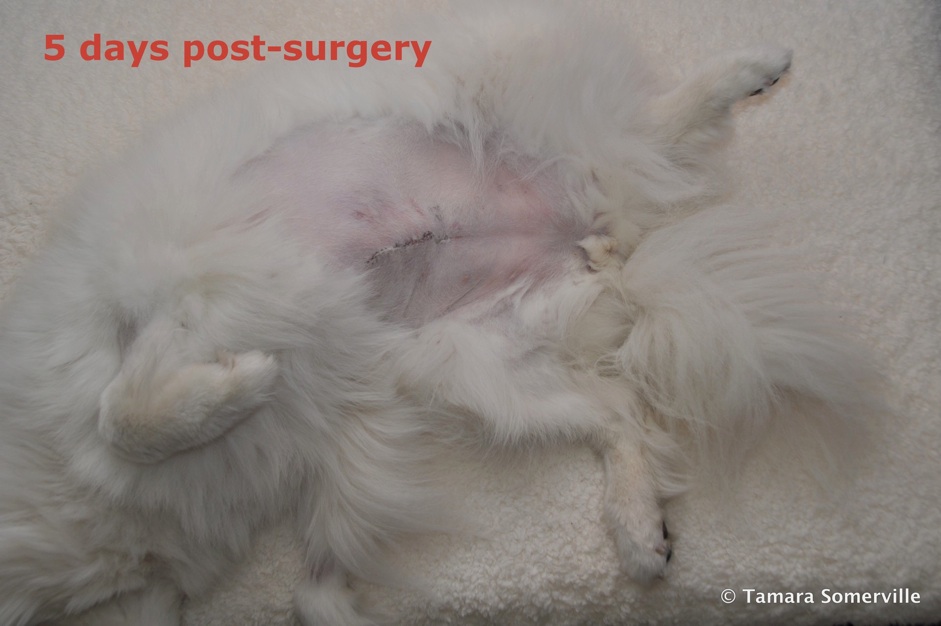
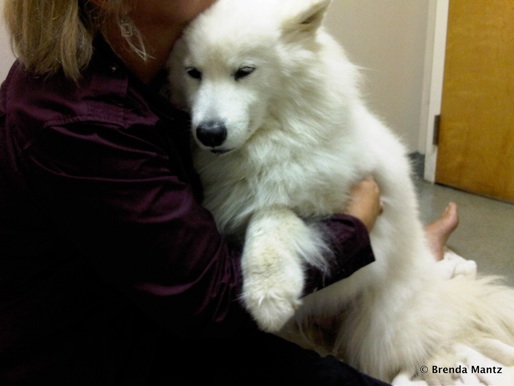
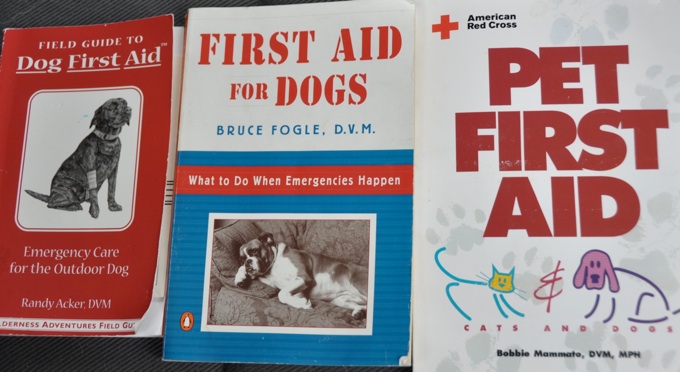
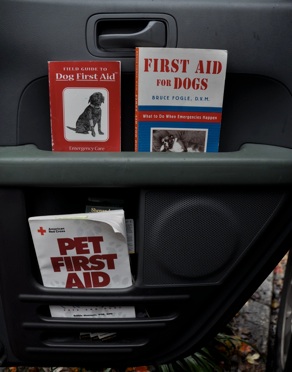


![Addendum (post-hospital highlights):
Gidget did not eat any food until Day 3. Doctors said this is not unusual after any major surgery. Brenda and I went to a nearby grocery and Petco to get a range of human and dog foods that might be alluring and which we left with the hospital. The doctors felt that it would also be helpful if I spent time with Gidget and personally tried to cajole her into eating. So they set a private room up for us and I sat on the floor with Gidget (and her buddy Blaze who I was sitting when the emergency occurred). On Days 2 and 3, the hospital allowed me to spend several hours with Gidget in a private room -- sitting and laying on a blanket with her, comforting and trying to get her to eat. Lauren, the great vet staffer who is now a Facebook friend, brought in several bowls with different foods and mixtures. Gidget was enticed by the Wellness Whitefish & Sweet Potato mixed with yogurt (Stonyfields - whole fat “cream on top”). She didn’t eat a lot of it but did manage several bites and this was a great step forward. She also sipped some water. After arriving home, Gidget happily ate boneless chicken breast, finely chopped and mixed with white rice. Several small meals a day (times, amounts and medications recorded in a journal). This is what vets call a “bland” diet and is frequently recommended when a dog is in some distress (from surgery, bouts of diarrhea, etc.).
Gidget came home from the hospital on Day 4. She also began to move her bowels regularly -- pooping once in the morning. Thank heavens for good friends. Jan Lynch and Karla Perez drove down (4 hours from DC) the day before, took me out to a nice dinner, and we caravanned back to DC with Gidget on Friday. Karla drove my car and Gidg and I rode with Jan so I could hold onto Gidget the entire time and keep a close eye on her. Gidget has long been prone to be anxious in the car -- a tendency that takes on a new significance now that I know the anxiety-bloat linkage.
The last pain pill (Tramadol) was Day 5. The day after we got home, Gidget took her last pain pill in the afternoon and I thought for sure both Gidget and I would have a sleepless night (I hadn’t slept much since the emergency). But she slept through the night (on my bed) and did not exhibit any apparent discomfort -- remarkable, I thought, considering the abdominal incision.
Day 6 - Gidget’s appetite and energy significantly recover. Not only was Gidget tolerating being off pain medication, she thrived on Day 6 -- with a rebounded appetite and choosing to walk to the end of our block (about 30 yards) whereas on her first two days home she’d walked only 20 feet before wanting to go back inside.
Day 7 - setback (vomiting). Gidget vomited breakfast about an hour after eating it. And then vomited a couple more times and ate a bunch of grass. I called Gidget’s normal vet and was advised to go a few hours without food and give Gidget 15mg of Pepcid AC, twice a day for a couple days, and boost Gidget’s food allotment. Gidget has a history of acid reflux and the vet and I agree I probably was being too stingy with the food. By that evening, Gidget seemed fine.
Day 9 - vet visit to check incision. For my peace of mind, my vet checked out Gidget for the first time and took a close look at the incision (which was closed with 19 staples). The doctor was very pleased with the surgeon’s work and the progress of Gidget’s healing. She also checked out Gidget’s vital signs and educated me on how to check the gums for signs of shock and some other First Aid essentials.
Day 12 - incision staples removed. Vet said large parts of the incision looked to be completely healed. Yay! Gidget delighted to have the staples gone and she did not so much as flinch during their removal (I held Gidget, who laid down - on the exam table while the doctor removed the staples). On the way to the vet, I had driven by a boutique pet store with a large stock of quality dog foods. I’m moving Gidget to a diet in which kibble is minimal and will eventually be absent. Mostly canned for now (Merrick’s). The November 2011 issue of Whole Dog Journal features a comprehensive article on the benefits of “high-quality wet dog foods” and contains a list of recommended canned foods. Merrick’s was one of the recommendations and I know Gidget likes it because a friend has treated her to some at her home. Highlights from the article (every dog person should subscribe to WDJ - at $15-20 annually, money very well spent which will help you give your pup a better quality of life and possibly a longer life):
“High-quality wet dog foods -- canned or pouched -- are healthier than dry dog foods.”
“...much more ‘natural’ than dry kibble with moisture content more comparable to meats, eggs, fruits and vegetables.”
“...usually contains more animal protein....” -- more suitable for dogs (they are carnivores).
“Most dogs digest high-quality wet foods with fewer problems (gas, vomiting, and diarrhea) than dry foods.”
“...far less adulterated with synthetic ingredients” (such as artificial colors and flavors)
On the canned food label, look for whole meat, fish or poultry as the first ingredient. The words “complete and balanced” should appear on the label. Some foods are marketed as “supplemental or intermittent”
For the list of recommended brands, please subscribe to Whole Dog Journal and then purchase the entire November 2011 issue or just this one article, entitled: “You Can. You should!”
Day 13 - Gidget’s doing stairs on her own. Until this day, Gidget was not walking stairs, at all. I was carrying her up and down all stairs. Lifting her in and out of the car (still am, she’s 9 years old and my SUV is a bit of a strain for her, even before the surgery) and on and off my bed at night. This was critical while the staples were still in and her incision was trying to heal. There were also internal stitches to be mindful of (those eventually dissolve). We don’t have a big yard and live in the middle of the city in a densely populated sea of rowhouses, so Gidget’s entire life has included three or four leashed walks a day. Leashed walks are the best bet when you are needing a dog to take it very easy while they recover from a major trauma like surgery and have wounds which need to heal. Also helps in this instance that Gidget is an “only child” - no other dogs to distract her from resting quietly.
Day 14 - Gidget’s energy and strength seem 100%. She’s pulling hard when on the leash and sees a friend (dog or person) and ran to the front door when I got out of the closet the bag containing her scooter harness. But she’s still weeks away from being completely healed so must be mindful. Two days after surgery, one of the attending physicians had estimated that it would be 4-6 weeks before Gidget was completely healed. “Completely healed” to me includes Gidget being able to pull me on a scooter. So we’ll see.
Day 19 - Gidget walks two miles. This would normally be unremarkable as we’re in the habit of doing 4 and 6-mile walks on weekends and at least a couple miles on weekdays. This two miles on Day 19 included a few hours of walking around a flea market, sitting outside for lunch at a cafe and hanging out on the lawn at the Capitol. She took a nice nap when we got home. A beautiful sunny day that was good for her spirits and mine.
Day 24 - back to a healthy norm. We’ve settled into the food routine pretty well. Gidget’s back to her norm of pooping twice daily and the stools are firming up. I still record in a journal every single meal (time, amount, specific food). This is to ensure that I’m feeding her enough but not too much and also to aid the vet in diagnosis if another bloat episode should occur (the gastropexy surgery should prevent further incidences of lethal torsion). I’m also recording in that journal every dosage of medicine (from the antibiotic cephalaxin to Pepcid AC) and a probiotic-digestive powder that I’m now sprinkling on one of her meals each day (Probiotics MAX - sold by Nature’s Farmacy).
Day 40 - Bikejoring. After consultation with her veterinarian, Gidget went bikejoring for the first time this (fall-winter) season and for the first time since the bloat surgery. I chose to bikejor rather than scooter because my pedaling took the stress of pulling off Gidget, allowing her to simply run/jog/walk. Two days short of the six week mark, she pulled strong and fast, as if nothing had happened. That’s due to her competitive spirit, as she was accompanied by six of her sammie buddies pulling scooters (Stoli, Theo, Shayla, Sarge, Blaze, Daffy). On Day 41, Gidget was clearly sore, not sure if that is due to her legs or abdomen. So we are taking it easy on Day 41, lots of naps and short walks. I’m carrying her up stairs for a couple days. Her appetite is strong.
Day 47 - Christmas in Middleburg Parade. Since before the bloat, I’d been planning on having Gidget pull a scooter in the PVSC’s first-ever appearance in the parade. Her evident soreness from Day 40’s bikejoring (which lasted until Day 42) made me hesitant to have her pulling a week later. But she had bounced back by Day 44 and the parade route was slated to be just a mile and the pace would be very slow so I harnessed her. Went great. She had a terrific time, mostly standing around at the staging area with over two dozen fellow sammies. Today, Day 48, she seems perfectly fine. We were both exhausted by the end of the day and slept hard and long. In a couple weeks I’ll try bikejoring with her again -- but less mileage than before and no fast sammies along to ignite her ultra-competitive spirit.
Day 50 (December 6, 2011) - Seven weeks since The Bloat. Big day for me, we’re past the oft-cited “4 to 6 weeks for full recovery.” Far as I’m concerned, she’ll be recovering all winter but it feels good to be well beyond the post-surgery period when complications are most likely to present.
Day 63 (December 19) - Nine weeks since The Bloat. Yesterday was the PVSC’s annual “Holiday Hike” on the National Mall. Gidget pulled the scooter & trailer -- and me a few times. It was a long day and she pulled hard for a couple long blocks, but she seems perfectly fine the day after, no indication of soreness. Unlike myself, who is taking Advil and rejoicing in the heating pad....
Four months (February 2012) - Finally found what looks to be the perfect source of food for Gidget: Honest Kitchen. There are several varieties (Zeal, Thrive, Love, Preference, etc.) and they are all dehydrated raw foods. Super healthy and -- big bonus -- super easy. A ten-pound box lasts Gidget about three weeks (one cup of food rehydrated with one cup of water in the morning, same regimen in the evening). Honest Kitchen is a great food for traveling, too. [ addendum January 2013: still loving HK ]
Two years + three months after (January 2014) - Gidget’s 11 1/2 years old now and doing great! Just yesterday she walked and bikejored (pulling two puppies in a trailer) about four miles on the National Mall. She’s happy, healthy and looks terrific. She’s still on Honest Kitchen’s “Thrive” variety and I’ve been delighted with it and she eagerly laps up every bowl (in the morning and evening). She’s exhibiting signs of arthritis in her back legs and has been for awhile. No major health issues since the bloat-torsion near-death experience in October 2011. Cherishing every day, knowing that each is a gift.
Four and a half years after (March 2016) - A couple times a year I re-read this article and feel so very blessed. Gidget was born on June 9, 2002. Today she is three months away from her 14th birthday. Yesterday, we walked 3.5 miles along the C&O Canal. When we parked at the trailhead, she was as excited as ever to jump out of the car and get moving. She pulled on the leash for the first mile. I brought her “Doggyride” stroller just in case she needed a lift, as I’ve been doing for several months now on long walks, but she never wants a lift. 3-4 miles is still a good distance for her. I think bloating in 2011 may have extended her life, because I took radical steps to optimize her health -- took her off kibble and soon settled on Honest Kitchen (Zeal, then the Thrive variety) for her food. Also made a serious effort to help her maintain a healthy weight -- stopped the Greenies and most other treats. In 2012, when Gidg turned ten, with the concurrence of her veterinarian I put Gidg on Cosequin DS. She was on Cosequin until a year ago when the vet decided it was time for Dasuquin -- a chewable that Gidg gets every morning and, surprisingly, loves as if it is a treat. These are supportive therapies for her joints and she is on no arthritis meds so her liver has been spared the assault of rimadyl and other such drugs. To ensure that Gidg has a healthy gut “flora” about 18 months ago her vet put her on a probiotic: Proviable DC -- a small capsule that each morning I pull apart and sprinkle the contents on Gidget’s breakfast. Most days I spritz on her dinner a bit of Aunt Jeni’s Home Made Fish Oil w/Vitamin E. The fish in that oil are wild caught sardines, herring, mackerel and anchovy. I also periodically give Gidg sardines that I buy at the grocery (packed in water, the less salt the better). That’s it. That is the totality of Gidget’s food/supplement regimen. We walk every day, because we live in the city and don’t have a big backyard and she likes to socialize in the neighborhood. So, grateful every day and am very, very thankful to have gotten these extra years with the Gidg.
April, 2016: Gidget’s semi-annual “Wellness Exam” results were great -- blood and urinalysis results were excellent for her age.
August 18, 2016 @ 8:00 a.m. -- Twenty hours ago, Gidget arrived at her BFFs, “The Blues Sisters,” for a play-date. She was very happy, especially when the three of them got to split a rotisserie chicken. A few hours later she jumped in the car to go home, where she ate her dinner and had a nap. It had been a good week, as she was especially frisky during the evenings and flung her indoor soccer ball at me to play with her. Twelve hours ago, while walking to the kitchen where her elevated food and water bowl stood, Gidget became severely uncoordinated to the point she could not stand. I rushed her to the emergency room. After several more such episodes and tests indicating cardiac malfunction and at least one mass on her liver or spleen, her attending physician concurred in a decision to euthanize. But first, Gidget and I had a last visit with me sitting on the floor of an exam room while she stood so I could give her the final armpit rubs and ear rubs that she had always savored. I looked into her eyes, studied her expression and listened to her slightly labored breath. It was time to let her go. She was 14 years, 2 months old. It had been nearly five years since she bloated.](Article_Bloat_and_Samoyeds_files/shapeimage_18.png)






Please feel free to post the link to this article anywhere you think it could be helpful.
- SYMPTOMS -
(These listed below are often, but not always, reported in bloat cases. If you merely suspect bloat could be occurring, get your dog in the car and start driving toward a veterinary hospital. Minutes matter in a bloat crisis.)
-
✤Unproductive vomiting (the oft-cited “Hallmark Symptom”)
-
✤Unproductive and perhaps uncomfortable efforts to poop
-
✤Anxiety/restlessness
-
✤“Odd behavior” (wants outside in the middle of the night, etc.)
-
✤“Hunched” posture
-
✤Lack of normal gurgling or digestive sounds
-
✤Bloated abdomen, may feel tight or hard (this is not always obvious)
-
✤Pale or off-color gums (dark red early on, pale, white or blueish in late stages)
-
✤Coughing
-
✤Heavy salivating or drooling
-
✤Foamy mucous around lips
-
✤Whining, pacing, may look at their side as if it hurts
-
✤Heavy or rapid panting, shallow breathing
-
✤Licking the air
-
✤Seeking a hiding place
-
✤May refuse to lie or sit down, may be unable to stand (late stages)
-
✤May stand spread-legged
-
✤May curl up in ball or go into praying or crouched position
-
✤May attempt to eat stones or twigs
-
✤Drinking excessively
-
✤Accelerated heartbeat, weak pulse, collapse (late-stage)
FIRST-AID: Keep a product with “simethicone” in your car, at home, in your backpack or wherever you take your dog. Such products include Gas-X. We got one Gax-X capsule down Gidget’s throat in the first 20 minutes of suspecting bloat. Discuss bloat and simethicone your veterinarian during your next visit. And please do your own Internet search in regard to “simethicone,” “Gas-X” and “dog bloat” for advice on dosage.

